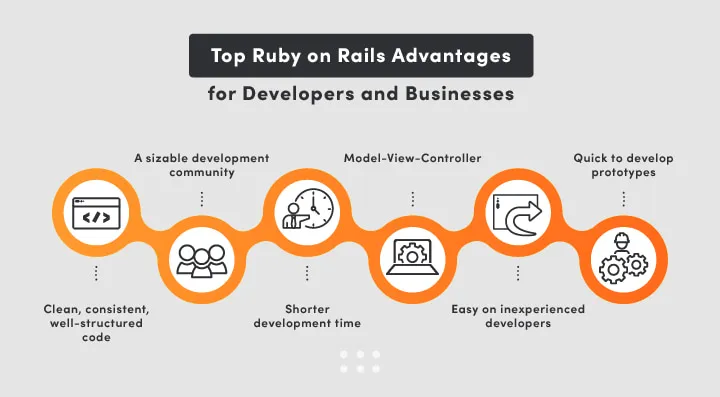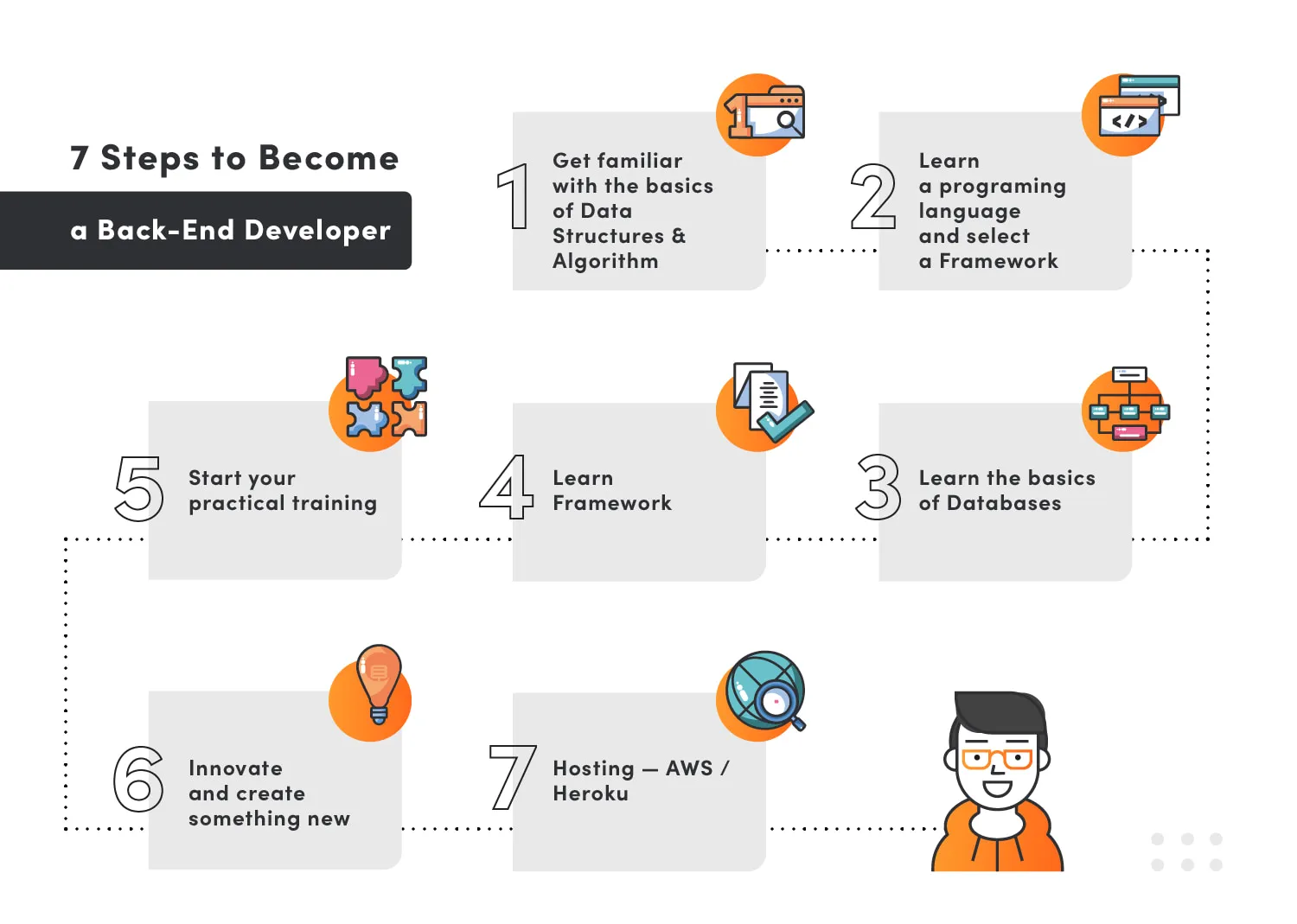Clicking on buttons, buying stuff online, and watching movies is fun, but it takes a lot of effort to develop these platforms. May it be a blogging site or a giant eCommerce store, every website is formed by two types of developers; front-end and back-end developers.
Back-end development is the skill that powers the web. Yet it does it modestly, allowing people to browse their favorite sites without even knowing about all the work put in by the back-end developer or team.
As of June 2021, the Internet contains more than 1.8 billion websites. Thanks to Covid-19, businesses are rapidly shifting from conventional shopping to online shopping, which increases the demand for the people responsible for coding, building, analyzing, and maintaining all those websites. The trend has increased business opportunities and creates a massive demand for Front-End and Back-end developers over the last two years.
So, what is back-end development? What are back-end languages? How to hire a back-end developer? To answer these and a lot more questions, we have compiled an article. Learn everything you need to know about back-end development in this post.
The Invisible Workforce - What is Back-end Development?
Web applications' back-end functionality is handled via back-end development languages. To deliver the final product to the end-user, back-end development works in collaboration with front-end development.
Back-end developers are generally concerned with the operation of a website. They produce code that concentrates on the function and logic that drives the product they're working on, and the technology they employ is never visible to users.
Writing APIs, writing code to connect with a database, developing libraries, focusing on business procedures and data design, and much more are all examples of back-end programmers' responsibilities. It is frequently dependent on the position and the organization.
Back end web developers work on tasks like:
- Building code
- Troubleshooting and debugging web applications
- Database management
- Framework utilization
3 Things You Need to Know About Back-end Development
There are three rules that you should keep in mind and these are as follows:
Front and back-end developers work in collaboration

Front-end development is a type of programming that focuses on a website's or app's aesthetic aspects. Back-end development, on the other hand, concentrates on the server-side. They collaborate to develop a dynamic website that allows users to make transactions, fill out contact forms, and engage in other activities while perusing the site.
Front and back-end developers have different strengths
Front and back-end developers have different skills. They are both crucial in building an attractive website that people will want to connect with. Front-end developers have strengths like graphic designing, converting UI/UX into HTML and more. Whereas, back-end developers show their strength in the areas like data-structuring or analytical skills by e.g. taking care of security and data protection, optimization of the app code to achieve maximum speed and scalability.
Front and back-end developers work in different languages
You will utilize a programming language when you are coding. These languages are similar to human languages, allowing programmers to interact with their computers using a set of symbols (referred to as code). To put it another way, it is the same as giving your computer commands. HTML, CSS, and JavaScript are among the languages used by front-end developers. JavaScript, Ruby, Elixir, Python, PHP, Java and many more are all used by back-end developers.
Try our developers.
Free for 2 weeks.
No risk. Just results. Get a feel for our process, speed, and quality — work with our developers for a trial sprint and see why global companies choose Selleo.
Back-end developer Tasks
A back-end developer's daily duties are as follows:
- hosting environment management
- administration of the databases
- building a well-documented API that is up to date with the standards
- taking care of the accessibility and security of the application
- keeping an eye on the reporting and error tracking tools to provide rapid feedback in case of the failures
- deploying the new versions of the application while keeping its high availability
- ensuring the data durability
The Developer's Gateway to the Web - Top Back-End Languages
Here’re the back-end languages:
Ruby
Ruby is still one of the top well-known backend programming languages. Ruby on Rails - one of the most popular web development frameworks in the market, allows you to rapidly develop your applications.
Top Ruby on Rails Advantages for Developers and Businesses
Below are a few of the most significant benefits of this framework.
- Ruby on Rails code is clean, consistent, and well-structured. Furthermore, this programming language is one of the world's most time-efficient frameworks.
- It has a sizable development community. As a result, if the developers run into any issues when developing a web app, they may call on a huge pool of resources.
- It cuts down on web app development time by allowing developers to reuse code to a larger extent.
- Model-View-Controller (MVC) is how Ruby on Rails (RoR) operates. This implies that the business logic can be separated from the rest of the program.
- The coding procedure in RoR is self-explanatory and understandable. As a result, inexperienced developers do not require any additional documentation to begin a new project.
Ruby on Rails allows the developer to create a prototype of the future website more quickly.

Elixir
A dynamic and functional programming language created for building scalable and maintainable applications. Although it is still relatively new, Elixir has been gaining popularity among back-end developers.
A few of Elixir advantages are:
- Clean syntax - it is easy to write and read Elixir code, although since Elixir is a functional programming language it might take a bit of time to get used to it
- Speed - speed matters for user experience and Elixir proves to have great performance
- Reliability - one of the strong sides of Erlang that is also true for Elixir thanks to a unique approach to fault-tolerance
- Scalability - Elixir allows easy scaling both vertically (using available machines more efficiently) and horizontally (adding more machines)
- Concurrency - Elixir can run multiple processes simultaneously while keeping them independent at the same time
To find out more about Elixir, go to our post Why Choose Elixir For Your Next Software Development Project?.
JavaScript
JavaScript is one of the most popular programming languages of 2021. Leveraging the Node.js runtime environment allows the use of JavaScript on the server-side. What is the reason behind this? Here're some of the reasons that you should know.
# 1: Taking advantage of all of JavaScript's features
As a result of the Node.js being a JavaScript-based runtime environment, adopting it for backend development gives you access to all of the advantages of this high-level programming language, the most essential of its widespread use.
# 2: Vertical and Horizontal Scalability
It allows you to scale your product in two different ways. On the one hand, it will enable you to scale it vertically by adding additional resources to an existing node. On the other hand, it makes it simple to expand the program horizontally by adding additional nodes.
# 3: High Performance
Node.js benefits from increased performance. All thanks to Google Chrome's JavaScript V8 engine, which converts the code directly into machine code, allowing for speedier implementation. Furthermore, Node.js provides non-blocking Input/Output operations. It simply implies that the requests are processed asynchronously rather than sequentially. This, in turn, results in a faster response time.
Python - On of The Most-Loved Programming Languages
Python is another programming language that keeps being on top of the popularity ranks over the years. Its simplicity is one of the reasons why so many programmers love it. Python's syntax is similar to that of the English language, making it simple and easy. It also eliminates the need for developers to employ low-level capabilities like memory management to do more complex tasks.
Here’re some reasons to love Python:
# 1: Python is supported by a large number of frameworks and packages
Python appears like a viable choice for backend development due to the abundance of frameworks and modules that allow developers to automate the execution of some tasks and, as a consequence, focus more on the application's business logic. Because each framework caters to a distinct set of requirements, the framework selected should depend on the project's demands. However, we would like to highlight two, in particular, today: Django and Flask.
# 2: Highly Optimized for Maximum Performance
When utilized with web development, machine learning, and fintech, Python can reach its full potential. Furthermore, because of its scalability, it is preferred among startups. Whether you are building a huge or small digital product, you will probably be able to locate an appropriate Python framework and a skilled team surprisingly easily.
PHP
PHP is a versatile and feature-rich backend programming language. It comes with built-in website creation tools. It encourages quick website building by using a simple framework. The app's developers may add functionality without having to write complicated and long code.
Developers may use this backend programming language to deal with a variety of database systems. PHP also simplifies typical web development chores such as session management, URL mapping, and caching, among others. The website is protected against attacks thanks to its built-in security measures.
# 1: Massive Community
PHP is a language with a large developer community and is extremely flexible; thus, most developers are familiar with it. PHP is also a very low-cost programming language. According to a developer poll conducted by Stack Overflow in 2020, it ranks second to last on the list of the top-paying technologies.
# 2: High Security
As a backend development language, PHP includes many built-in security measures that make it extremely safe. These security features allow many threads to be mitigated for improved system security.
# 3: Simple to Use
PHP is a versatile programming language that may be used for a variety of tasks. It's simple to use and set up, and it can readily handle current requirements such as database integration. It is also a great language for newbies because it's simple to learn. The fact that it takes less time to have a solid handle on it attracts new developers.
Golang
The second recommendation for backend development is Go, commonly known as Golang, a statically typed, compiled programming language. It was released in 2009 and has already been voted TIOBE's Programming Language of the Year twice. Although being considerably less prominent than Python, it was cited as the fifth most popular technology by 62.3 % of Stack Overflow poll respondents in 2020.
Here’re some of its benefits:
#1: Gradual Learning Curve
Go is simple to comprehend and utilize for newcomers to programming and experienced developers. There is an interactive Tour of Go on the Go website that you can use to familiarize yourself with the language. The simplicity of Golang's code, on the other side, makes it simple for experts with experience in other programming languages, such as C# or C++, to learn.
#2: Concurrency Support
One of the primary advantages of Golang is that it has a significant impact on the app's seamless and effective operation. To put it differently, concurrency allows two or more processes to operate simultaneously while being independent of one another.
7 Steps to Become a Back-End Developer

Follow these seven steps to become an expert back-end developer:
Step 1: Get familiar with the basics of Data Structures & Algorithm
Knowing the fundamentals of data structure and algorithms is always a good idea. You should have a clear understanding of the process. Basic Data Structures and Algorithms such as Stack, Queue, Linked List, Tree, Graph, Hashing, Sorting & Searching Algorithms, and other essential programming principles should be reviewed.
Step 2: Learn a programing language and select a Framework
Decide on a schedule and the fundamental programming languages you want to master.
You may learn various programming languages at the same time, but it is much easier to focus on one at a time.
Step 3: Learn the basics of Databases.
There are several incredibly simple relational database management systems from which to choose. Almost every website today has some form of storage, so understanding databases are always useful.
Step 4: Learn Framework/s
You can understand the foundations of at minimum one framework based on the programming language you prefer. Most frameworks follow the MVC (Model-View-Controller) concept, whether it's Django or Ruby-on-Rails. Using frameworks allows you to develop templates and code that can be subsequently reused. As a response, your productivity improves. Learning a framework is also a smart idea in this situation.
Step 5: Start your practical training.
To better understand the ethical knowledge that you have acquired so far, you must utilize the methods and practices daily. Working on little tasks or assignments is the best method to achieve this. Start with easy projects like a to-do list, a blog, a photo gallery web app, a résumé builder, and a basic project management tool.
Step 6: Innovate and create something new
It's a fantastic idea to start with a startup clone. It implies that you would clone some existing items on the market. Additionally, you might be interested in the following websites/apps.
- Buffer — A Smarter Way to Share on Social Media — Scheduling posts for various Social Media channels.
- Hello Bar — Simple JavaScript plugin to help you in getting your marketing stuff done.
- Airbnb / Fiverr — Marketplace of anything
Step 7: Hosting
Now it's time for you to expand your wings! Use a cloud service provider to host your product so that it can be accessible over the internet. AWS is a good option because it offers roughly a year of free hosting (limited usage).
Read also: A Simple Guide to Google DevTools
Must-Have Back-End Developer Skills
An expert back-end developer poses the following skill sets:
Skill #1: Programming Language and Framework
Mastering a programming language is required to be a professional back-end developer. To interact with the frontend of the web application, back-end code written in a specific language is used.
Skill #2: Database Management
When a client requests data, the back-end acts as a middleman, retrieving and sending the appropriate response from the database to the client. A client can also contribute information for inclusion in the database.
As a back-end developer, you must understand database technologies such as MongoDB or PostgreSQL and caching (e.g. Redis) for fast data access.
Skill #3: Handling APIs
A bridge layer between two programs is an Application Programming Interface (API). It takes requests for data from a back-end application, obtains it, and sends it back as a response message.
Skill #4: Version Control
All prior variants of your code are stored in repositories by software version control systems so that they may be accessible later. It is important, especially if you misplace a piece of code or generate an error.
You may roll back to a prior version of the codebase using a software version control system like Git.
Need a Backend Developer? Here's How to Get One

If you are looking to hire a professional, skilful and expert back-end developer then include these questions in your interview chart.
Interview Questions
- What REST stands for?
- What are NoSQL databases? What are the different types of NoSQL databases, how do they differ from SQL databases?
- What is SQL injection?
- Difference between the integrance test and the unit test?
- Name some Performance Testing best practices
- What are the DRY and SOLID principles?
- What are the differences between continuous integration, continuous delivery, and continuous deployment?
Steps to Hire a Back-End Developer
- Check the developer's work with his/her prior clients. If the references are good, the next approach is to break it slow and steady.
- Conduct the interview and ask technical questions as shared above.
- Assign them a minor part of the project and observe how it goes; if everything goes well, move on; if not, find another developer.
Steps to Outsourcing to SDH / Dedicated team or Staff Augmentation
- Prepare a long list of candidates (you can review catalogues like Clutch or Goodfirms, check LinkedIn or pro-made lists, ask around others in your industry or simply Google it)
- Narrow down your choices
- The ideal offshore crew is a key step towards successful outsourcing for your project. Your outsourcing partner should be capable of bringing in the best and brightest.
- Because outsourcing is a complex process with such high financial stakes, having only the best of the best on your team at all times is essential.
- Check their portfolio and verify it from their past or existing clients.
- Read reviews of their old clients
- Check their blog and see if they are posting informational articles frequently.
Conclusion for Aspiring Developers
If you are thinking about a career in development, I would suggest looking at the job requirements for the positions you are interested in and making a list of the languages that come up frequently. Then, utilizing back-end language classes like the ones mentioned above, begin studying them.
Don't be put off by the industry jargon. Remember that everyone who is an expert at something was once a rookie.
Conclusion for Businesses Searching for Back-End Developers
As an organization, you must adopt a strategic approach to IT outsourcing and carefully choose resources. A less costly solution might not provide you with the competitive edge you are looking for.
Investing in a long-term partnership with a respected development service provider who takes the time to analyze your needs and provides a diverse variety of services is a cost-effective option.
At Selleo, we have a team of the best and most skilful developers who can fulfil all your web & app development needs. If you need any guidance, contact us now!





